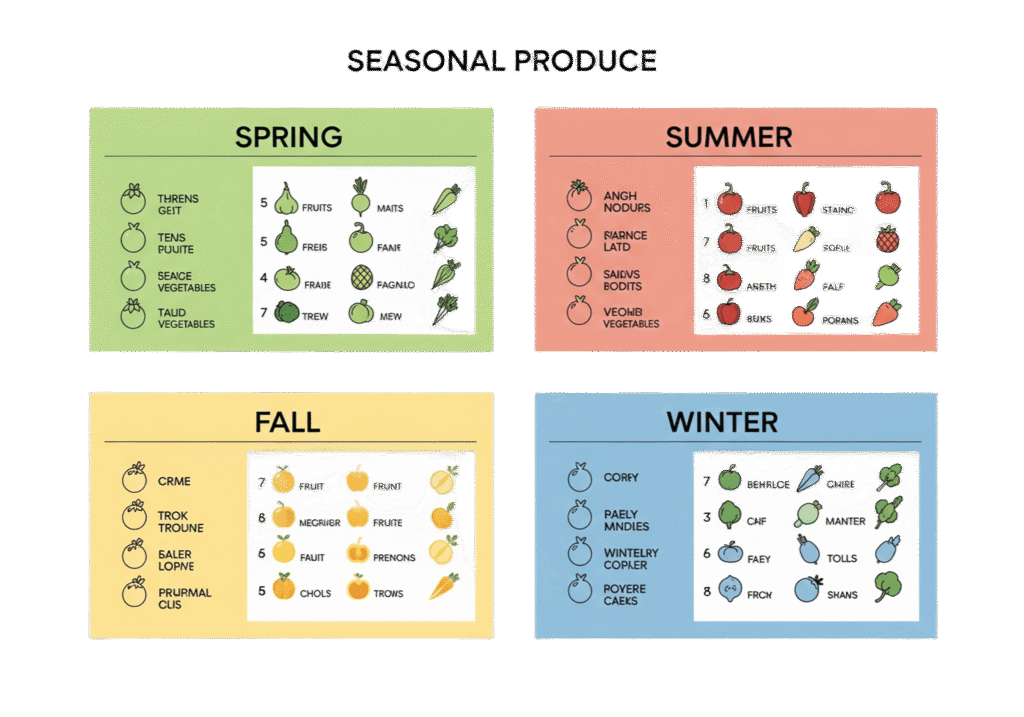- Maximum Flavor & Nutrition: Produce picked at the peak of its season has a more intense flavor and is packed with more nutrients. It hasn’t spent weeks traveling, losing freshness and vitamins.
- Significant Cost Savings: When a crop is in abundance, its price goes down. By shifting your diet to align with what’s naturally available, you can save a considerable amount of money on your grocery bill. It’s a simple, effective budget-friendly strategy.
- Support for Local Farmers: Buying seasonal produce often means buying local, supporting farmers in your community and reducing the environmental impact of long-distance transport. This contributes to a more sustainable-living approach.
- Variety & Excitement: Eating seasonally encourages you to try new things and adds variety to your diet, preventing mealtime boredom.
A Quick Guide to Seasonal Produce in the U.S.

Knowing what’s in season can feel overwhelming. Here’s a simple breakdown of what’s typically at its peak in each season across the United States.
Spring (March – May):
- Vegetables: Asparagus, Artichokes, Broccoli, Kale, Leafy Greens (lettuce, spinach), Peas, Radishes.
- Fruits: Strawberries (late spring), Rhubarb, Cherries.
Summer (June – August):
- Vegetables: Corn, Cucumbers, Eggplant, Bell Peppers, Tomatoes, Green Beans, Zucchini.
- Fruits: Berries (blueberries, raspberries), Melons (watermelon, cantaloupe), Peaches, Plums, Figs.
Fall (September – November):
- Vegetables: Squash (butternut, acorn), Pumpkin, Cauliflower, Cabbage, Brussels Sprouts, Sweet Potatoes, Onions, Mushrooms.
- Fruits: Apples, Pears, Cranberries, Grapes, Pomegranates.
Winter (December – February):
- Vegetables: Root vegetables (carrots, potatoes, turnips), Winter squash, Kale, Cabbage, Onions, Leeks.
- Fruits: Citrus fruits (oranges, grapefruits, lemons), Pears, Kiwi.
Smart Shopping Strategies for Seasonal Produce
To get the most out of your seasonal shopping, try these smart grocery shopping tips:
- Hit the Farmers Market: local farmers market is your best friend for fresh, seasonal produce. You can talk directly to the growers, often get better prices for bulk purchases, and find unique varieties.
- Check Supermarket Flyers: Even large supermarkets run sales on what’s in season. Use their weekly circulars to guide your shopping list.
- Buy with a Plan: Just like building a stockpile, buy seasonal produce with a purpose. Plan meals around what’s on sale to ensure you use everything before it spoils.
- Embrace Imperfection: “Ugly” or oddly-shaped produce is just as delicious and nutritious. They often sell at a discount and are perfect for soups, smoothies, or sauces.
🍎Beyond the Fresh: Storage & Preparation for Maximum Value
What to do when you have more seasonal bounty than you can eat? Don’t let it go to waste! Mastering storage and preparation is key to combating food waste.
- Freezing: Most fruits and vegetables can be frozen. Berries can be frozen whole on a baking sheet before being transferred to a bag. Vegetables often need to be blanched (briefly boiled, then plunged in ice water) before freezing to maintain color and texture.
- Canning & Jamming: If you enjoy kitchen projects, canning summer tomatoes or making jam from berries is a fantastic way to preserve flavor.
- Drying: Herbs from your garden or thinly sliced fruits can be dried for long-term storage.
- Repurpose: Overripe fruits can be used for smoothies or baking. Soft vegetables can be added to soups or stews. This aligns perfectly with a sustainable-living mindset.
🥕 The Nutritional Payoff: Eating Your Vitamins
Eating a variety of seasonal fruits and vegetables is one of the best ways for seniors to get the essential vitamins for seniors and minerals they need for a healthy, active life.
- Vitamin C: Abundant in citrus fruits (winter), berries (summer), and bell peppers (summer/fall). Great for immune support.
- Vitamin A: Found in carrots, sweet potatoes, and leafy greens. Crucial for eye health.
- Potassium: Rich in bananas (available year-round), sweet potatoes, and spinach. Supports heart health.
- Fiber: High-fiber foods like apples, pears, and berries are great for digestive health.
Consider incorporating these nutrient-packed foods into your daily meals. If you are looking for convenience, some people find that an organic produce delivery service or a healthy eating subscription box can help them discover new seasonal items they might not have considered before.
💡For more detailed information on the nutritional benefits of different fruits and vegetables, consult resources from the USDA’s MyPlate (https://www.myplate.gov/eat-healthy/fruits and https://www.myplate.gov/eat-healthy/vegetables)
👉 A Delicious Path to Health & Savings
Making seasonal fruits and vegetables a priority in your diet is a simple yet powerful lifestyle change. It’s a delicious way to enjoy food at its peak, support your local community, and reduce your grocery bills. By following these practical tips, you can transform your shopping habits into a smart, budget-friendly, and deeply rewarding part of your healthy, senior-wellness journey. Happy shopping and happy eating!
Frequently Asked Questions (FAQ)
Q1: Is organic produce always better than conventional? A1: While organic can have benefits, a focus on eating plenty of fruits and vegetables (whether organic or not) is the most important factor for a healthy diet. Buying in-season is often a good compromise, as the produce is fresher and often requires fewer interventions.
Q2: Where can I find a seasonal produce guide for my specific state? A2: Many university extension services and local government websites offer regional guides. A quick search for “[your state] seasonal produce calendar” can help you find a local guide.
Q3: How can I tell if produce is fresh? A3: Look for vibrant colors, a firm texture, and a pleasant smell. Avoid items with brown spots, bruises, or limp leaves.
Q4: Can I use seasonal produce for meal planning? A4: Absolutely! Start your meal planning by looking at what’s on sale and in season, then build your meals around those ingredients. This is a very effective way to save money and reduce food waste.
Read more: To ensure maximum freshness and economy, consider growing your own vegetable garden in pots: Easy Home Gardening for Seniors (Even in Small Spaces!).




